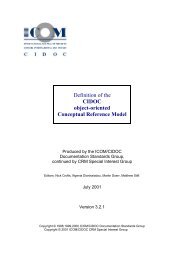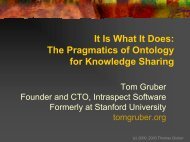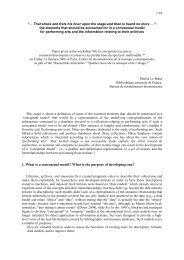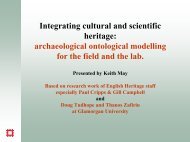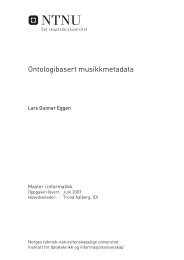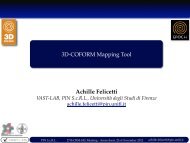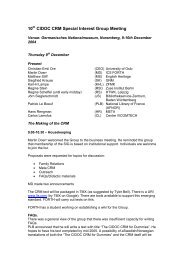documenting cultural heritage in small museums - The CIDOC CRM
documenting cultural heritage in small museums - The CIDOC CRM
documenting cultural heritage in small museums - The CIDOC CRM
Create successful ePaper yourself
Turn your PDF publications into a flip-book with our unique Google optimized e-Paper software.
DOCUMENTING CULTURAL HERITAGE IN SMALLMUSEUMSChryssoula Bekiari, Leda Charami, Mart<strong>in</strong> Doerr, Christos Georgis, Ath<strong>in</strong>a KritsotakiInstitute of Computer ScienceFoundation for Research and Technology - Hellas (FORTH)N. Plastira 100, Vassilika Vouton, GR-700 13Heraklion, CreteGreeceE-Mail: {bekiari, lida, ath<strong>in</strong>ak, mart<strong>in</strong>, georgis}@ics.forth.grURL: www.ics.forth.gr/isl- I agree that my paper may be available on-l<strong>in</strong>e to the conference web site and/or to the <strong>CIDOC</strong> website (<strong>in</strong> pdf-format). YesAbstractThis paper describes requirements for documentation of collections <strong>in</strong> <strong>small</strong> <strong>museums</strong> andpresents a <strong>CIDOC</strong> <strong>CRM</strong>-based IT solution. This solution has been elaborated by the Centre forCultural Informatics <strong>in</strong> ICS-FORTH <strong>in</strong> close collaboration with a series of <strong>small</strong> <strong>museums</strong> and<strong>cultural</strong> <strong>in</strong>stitutions <strong>in</strong> Greece. A detailed, but generic XML Schema fully compatible with the<strong>CIDOC</strong> <strong>CRM</strong> model for museum object documentation and a light-weighted database solutioncalled “Synthesis”, which can easily be adapted to special requirements, has been developed.In this paper we present the analysis of the generic schema employed, the system design andfunctions, and the experience from parallel development of the system for three fairly differentclients.IntroductionWhereas large <strong>museums</strong> are quite visible magnets for the public, much of our knowledgeabout the past is kept <strong>in</strong> <strong>small</strong> <strong>museums</strong>. <strong>The</strong>re are characteristic differences <strong>in</strong> organizationand procedures to their larger counterparts, which is also reflected <strong>in</strong> their documentationrequirements. Typical <strong>small</strong> <strong>museums</strong> may be one–object <strong>museums</strong>, such as a ship museum,a museum about a famous person, a house museum, a local history museum etc., or be basedon the donation of a private collector. Most of them have also an archive and a <strong>small</strong> library
directly related to their subject. Compared to their larger counterparts, <strong>small</strong> <strong>museums</strong> tend tohave a <strong>small</strong>er budget, but significantly less objects per curator and very low adm<strong>in</strong>istrationaloverhead. <strong>The</strong>refore they can afford more detailed documentation of their objects, butfrequently, their objects are highly heterogeneous with a lot of contextual cross-correlationsbetween them, which makes documentation more demand<strong>in</strong>g. In any case, <strong>small</strong> <strong>museums</strong>are closer to their communities and are seen as less <strong>in</strong>timidat<strong>in</strong>g than their largercounterparts. This enables <strong>small</strong>er <strong>museums</strong> to be more responsive to community needs; to bemore flexible, more focused and more able to develop a shared vision amongst their staff.Ontology is the science of what is, of k<strong>in</strong>ds and structures of objects, properties, events,processes and relations <strong>in</strong> every area of reality [1]. Ontology seeks to provide a def<strong>in</strong>itive andexhaustive classification of the entities and their possible relationships of a part of worldunder <strong>in</strong>vestigation. Formal ontologies provide models of possible states of affairs <strong>in</strong> some“universe of discourse”. More and more, the employment of ontologies is regarded beneficialfor design<strong>in</strong>g a suitable data structure for <strong>document<strong>in</strong>g</strong> museum objects or material <strong>cultural</strong><strong>heritage</strong> <strong>in</strong> general.<strong>The</strong> question is which ontology to use and what method to follow for transform<strong>in</strong>g theontology to a data structure.In this paper, we present our approach for <strong>small</strong> <strong>museums</strong>, based on <strong>CIDOC</strong> <strong>CRM</strong>, whichother implementers may like to follow.From Ontology to data model<strong>The</strong> <strong>CIDOC</strong> <strong>CRM</strong> [2] reference ontology is the most appropriate for be<strong>in</strong>g used for thedocumentation of <strong>cultural</strong> entities s<strong>in</strong>ce it def<strong>in</strong>es and is restricted to the underly<strong>in</strong>g semanticsof database schemata and document structures used <strong>in</strong> <strong>cultural</strong> <strong>heritage</strong> and museumdocumentation <strong>in</strong> terms of a formal ontology. It does not def<strong>in</strong>e any of the term<strong>in</strong>ologytypically appear<strong>in</strong>g as data <strong>in</strong> the respective data structures; however it foresees thecharacteristic relationships for its use. It does not aim at propos<strong>in</strong>g new th<strong>in</strong>gs about what<strong>cultural</strong> <strong>in</strong>stitutions should document. Rather it expla<strong>in</strong>s the logic of what they actually use todocument, and thereby <strong>in</strong>tends to enable enables semantic <strong>in</strong>teroperability.<strong>The</strong> <strong>CIDOC</strong> <strong>CRM</strong> is <strong>in</strong>tended to facilitate the <strong>in</strong>tegration, mediation and <strong>in</strong>terchange ofheterogeneous <strong>cultural</strong> <strong>heritage</strong> <strong>in</strong>formation and is the culm<strong>in</strong>ation of more than a decade ofstandards development work by the International Committee for Documentation (<strong>CIDOC</strong>) ofthe International Council of Museums (ICOM).2
When transferr<strong>in</strong>g ontology <strong>in</strong>to a data model, epistemological issues appear such as: <strong>in</strong>which form and units is the knowledge provided, used and managed? What are its sources?What are the units, and boundaries of documentation, and how to represent alternatives?Also the processes of creation and dissem<strong>in</strong>ation of knowledge about <strong>cultural</strong> entities has tobe addressed. In the follow<strong>in</strong>g, we try to illustrate the impact of these questions on the datastructure design.Usually <strong>in</strong> <strong>small</strong> <strong>museums</strong> the adm<strong>in</strong>istrational actions needs no workflow control and can bedealt with simple registration on a per object base. This has the advantage that the sum of<strong>in</strong>formation about a museum object can be packed <strong>in</strong>to one document. <strong>The</strong> data organizationof this “one” document is an epistemological issue: the def<strong>in</strong>itions of its parts are based onfunctional units, so that the user has an easy orientation where to f<strong>in</strong>d <strong>in</strong>formation for aparticular task. <strong>The</strong>refore we dist<strong>in</strong>guish the follow<strong>in</strong>g parts [3]:• Object and document identification,• description of present state• historical description,• adm<strong>in</strong>istration data• references.Whereas these parts do not correspond to entities <strong>in</strong> the ontology, the data elements thatconstitute the parts are mapped directly or <strong>in</strong>directly to the chosen ontology. By “mapp<strong>in</strong>g”we mean a set of equivalence statements between data structure parts and paths <strong>in</strong> theontology which allows for def<strong>in</strong><strong>in</strong>g a determ<strong>in</strong>istic data transformation algorithm from thedata structure <strong>in</strong>to an <strong>in</strong>stance of the ontology, e.g., <strong>in</strong> RDF encod<strong>in</strong>g. <strong>The</strong> nature of the RDFrepresentation is that of a network. RDF propositions “thrown” <strong>in</strong>to one pool of data <strong>in</strong>tegrateautomatically via URLs <strong>in</strong>to one large network of knowledge.One may regard data elements that are mapped directly to the <strong>CIDOC</strong> <strong>CRM</strong> to be ofontological nature: <strong>The</strong>y deal with the relationships of th<strong>in</strong>gs, people, events, time and place.Other data elements serve more the recognition and identification of objects by characteristicsthan their historical relevance, such as color and basic material. We regard the latter asepistemological and map them to the properties “P3 has note” (E1 <strong>CRM</strong> Entity.P3 has note:3
E62 Str<strong>in</strong>g) and the “P2 has type” (E1 <strong>CRM</strong> Entity.P2 has type (is type of): E55 Type) of the<strong>CIDOC</strong> <strong>CRM</strong>.In a way, all data may be regarded as epistemological once they appear <strong>in</strong> a document: <strong>The</strong>yare statements of what has been understood. It is only the subject matter, the mean<strong>in</strong>g ofsome of the statements that consists of possible states of affairs of the th<strong>in</strong>gs under<strong>in</strong>vestigation, the ontological view. <strong>The</strong>refore, there are always two k<strong>in</strong>ds of mapp<strong>in</strong>g: One tosee the document as a document and as statements how the knowledge was acquired, andanother based on its propositions about reality. For <strong>in</strong>formation <strong>in</strong>tegration, we need thelatter. For understand<strong>in</strong>g what to believe, we need the former. In order to turn an ontology<strong>in</strong>to a document format, we have to add the epistemological part. In order to <strong>in</strong>tegrate<strong>in</strong>formation, we have to get rid of it. An <strong>in</strong>tegrated <strong>in</strong>formation environment must preserveboth views. <strong>The</strong> epistemological has priority: if it lost, we cannot <strong>in</strong>terpret knowledge. Wecan reconstruct the ontological view from it, if it is suitably organized.Most data elements <strong>in</strong> our format are based on repetitions of a basic event pattern. Thispattern is based on the idea that history is represented by th<strong>in</strong>gs, people and ideas meet<strong>in</strong>g <strong>in</strong>space and time. <strong>CIDOC</strong> <strong>CRM</strong> focuses on event model<strong>in</strong>g <strong>in</strong> order to describe <strong>cultural</strong>materials and scientific observations. <strong>The</strong> event pattern is a strong mechanism [4], [5] for<strong>in</strong>tegrat<strong>in</strong>g heterogeneous complementary <strong>in</strong>formation and an advantage of its use is that allthe data elements follow<strong>in</strong>g this pattern can directly be mapped to the <strong>CIDOC</strong> <strong>CRM</strong>.<strong>The</strong> data model, which realizes the event pattern, <strong>in</strong>cludes the follow<strong>in</strong>g basic elements(mapp<strong>in</strong>g to the <strong>CRM</strong> <strong>in</strong> parentheses):(i) event ID (<strong>CIDOC</strong> <strong>CRM</strong> E5 Event:P1 is identified by :E41 Appellation),(ii) event type (<strong>CIDOC</strong> <strong>CRM</strong> E5 Event:P2 has type: E55 Type)(iii) event name (<strong>CIDOC</strong> <strong>CRM</strong> E5 Event:P2 has type: E55 Type),(iv) event date, (<strong>CIDOC</strong> <strong>CRM</strong> E5 Event: P4 has time-span:E52 Time-Span:P82 atsome time with<strong>in</strong>: E61 Time Primitive)(v) event place (<strong>CIDOC</strong> <strong>CRM</strong> E5 Event:P7 took place at :E53 Place),(vi) participants and their role <strong>in</strong> the event (persons, organizations, objects etc)(<strong>CIDOC</strong> <strong>CRM</strong> E5 Event:P12 occurred <strong>in</strong> the presence of: E39 Actor/ E70 Stuff),(vii) event description (<strong>CIDOC</strong> <strong>CRM</strong> E5 Event:P3 has note: E62 Str<strong>in</strong>g),(viii) event scope (<strong>CIDOC</strong> <strong>CRM</strong> E7 Activity: P21 had general purpose: E55 Type), (ix)method or technique (<strong>CIDOC</strong> <strong>CRM</strong> E5 Event: P12 occurred <strong>in</strong> the presence of:4
(ix)(x)E77 Persistent Item),relation with other events (<strong>CIDOC</strong> <strong>CRM</strong> E5 Event: P9 consists of: E5 Event:)Outcome (<strong>CIDOC</strong> <strong>CRM</strong> E5 Event: P12 occurred <strong>in</strong> the presence of: E77Persistent Item).<strong>The</strong> follow<strong>in</strong>g table 1 presents the parts and their major subparts of the object document.Table 1. Data organization of the object documentpart subpart Sub-sub partsDocument / RecordIdentificationRecord Identification,Version numberObject identification Current Inventory number,Other numbers,Responsible organization,collection, Objectcategory, Basic material,Basic color, Objectcomposition, Object parts,Subpart of <strong>in</strong>ventory id,representative image,accessories, condition, <strong>in</strong>houseDetaileddocumentationObject description Object names, Type, Depiction, Mark& Inscriptions, Measurements,Condition checkObject historyProduction, Usage, Field collection,Intervention/Modification, OwnershipObject relationsManagement Accession, OtherAccessions, Acquisition,Locations, Packag<strong>in</strong>g,Contract, Movement,5
Loan out, DeaccessionReferences Bibliographic reference,Archival reference, Otherclassification, Evidences,Texts<strong>The</strong> identification of the document comprises the requirement of record<strong>in</strong>g the metadataabout its creation <strong>in</strong> the document itself. Follow<strong>in</strong>g the event pattern, the creation of thedocument is an event and the assign<strong>in</strong>g of an identification number is also an event. <strong>The</strong>“Document / Record Identification” data element <strong>in</strong> Table 1 represents the document creationevent. <strong>The</strong> “Record Identification” and the “Version Identification” data elements representthe associated events of document identification number creation and the document versionnumber creation event respectively. <strong>The</strong> detailed data elements of this part are presented <strong>in</strong>the Annex A. Note that these metadata play an epistemological role with respect to thesubject matter of the document, but simultaneously, they play an ontological role with respectto the history of documentation itself. <strong>The</strong> <strong>CIDOC</strong> <strong>CRM</strong> models this case, but it does not dealwith the details of <strong>in</strong>ternal object structure and how to recognize an object.<strong>The</strong> data elements that constitute the “Object identification” part are all those necessary fortrac<strong>in</strong>g an object <strong>in</strong> the <strong>in</strong>ventory, for follow<strong>in</strong>g an object <strong>in</strong> history via tradition of identifiersand for recogniz<strong>in</strong>g an object <strong>in</strong> the case it is miss<strong>in</strong>g or stolen.<strong>The</strong> “Current Inventory Number” data element is used for trac<strong>in</strong>g the object <strong>in</strong> the Inventoryand its structure follows the above event pattern. <strong>The</strong> “Other numbers” data element is usedfor trac<strong>in</strong>g the object <strong>in</strong> the history, <strong>document<strong>in</strong>g</strong> all the previous assigned identificationnumbers used for referenc<strong>in</strong>g the object <strong>in</strong> the museum or by other owners. <strong>The</strong> data element“basic material” and “basic color”, “Object parts”, “Representative image”, “Generaldescription” and “condition” are required for object recognition. <strong>The</strong> detailed data elementsof this part are presented <strong>in</strong> the Annex A.<strong>The</strong> “Detailed documentation” part consists of three major subparts. <strong>The</strong> first subpart“Object description” supports the documentation of current description of the object as it canbe observed and justified by the curators today. <strong>The</strong> structure of all data elements of this partis based on the event pattern, except the “Type” data element which supports the scientific6
classification of the object. <strong>The</strong> second subpart “Object history” supports all the <strong>in</strong>formationabout events at which an object was present and constitutes the known history of the object.This <strong>in</strong>formation is found <strong>in</strong> historical sources and evidences and it is not observable today.<strong>The</strong> structure of all data elements of this part is event-based and these data elements mapeither to <strong>CIDOC</strong> <strong>CRM</strong> E7 Activity or to specializations of this class. <strong>The</strong> above separation of“Object description” and “Object history” is a pragmatic one and it is useful when the state ofthe object is “relatively” stable with<strong>in</strong> the time frame of consideration.<strong>The</strong> sub parts of “Object description” and “Object history” are slightly different when thedocumentation is about build<strong>in</strong>gs or archaeological sites. <strong>The</strong>y change significantly over thetime under consideration. For example <strong>in</strong> the case of monument decoration, there is a dataelement “Decoration” <strong>in</strong>stead of “Depiction” <strong>in</strong> “Object description” part which supports thecurrent observable decoration of the monument and there is a “Other decorations” dataelement <strong>in</strong> “Object history” part for support<strong>in</strong>g the descriptions of decorations that amonument had <strong>in</strong> the past and they are not observable now. <strong>The</strong>y are known by references <strong>in</strong>old designs, books, old pictures, etc. Also there are additional data sub elements <strong>in</strong>“Production”, “Use” and “Intervention/Modification” for describ<strong>in</strong>g the composition of thebuild<strong>in</strong>g <strong>in</strong> historical times. <strong>The</strong> third subpart of the data elements support the documentationof the object relations with other events or with other similar objects by type or by style etc.<strong>The</strong> “Management” part supports the documentation of the events and procedures occurr<strong>in</strong>g<strong>in</strong> the museum <strong>in</strong> which the object participates. <strong>The</strong> structure of these data elements is eventbased. <strong>The</strong>y are mostly trivial events <strong>in</strong> the history of the object but they are essential tomuseum adm<strong>in</strong>istration. Part of them may be regarded “history” at a later stage.<strong>The</strong> last part, “Reference”, comprises the associations of source material that refers to objector describes the object. Source material may be photos, designs, texts, archives,bibliographic reference. It may be digital or not.<strong>The</strong> system design and functions<strong>The</strong> characteristics of <strong>small</strong> <strong>museums</strong> and the required data model constitute a particularchallenge for build<strong>in</strong>g collection management systems. <strong>The</strong> demand is the support of theabove data model for address<strong>in</strong>g semantic <strong>in</strong>teroperability via data <strong>in</strong>tegration as well as thesupport of structured data exchange (<strong>in</strong> the form of XML documents) for syntactic7
<strong>in</strong>teroperability. <strong>The</strong>refore the Centre for Cultural Informatics <strong>in</strong> ICS-FORTH has developeda detailed, but generic XML Schema of the proposed data model for museum objectdocumentation <strong>in</strong> close collaboration with a series of <strong>small</strong> <strong>museums</strong> and <strong>cultural</strong> <strong>in</strong>stitutions<strong>in</strong> Greece, and a light-weighted database solution called “Synthesis”, which can easily beadapted to special requirements <strong>in</strong> order to keep customization cost low.<strong>The</strong> organization <strong>in</strong> XML [6] documents allows the dynamic exploitation of the data <strong>in</strong> the<strong>in</strong>ternet and supports additional translations of the same document <strong>in</strong> more than onelanguage. It is the best solution for data exchange between <strong>cultural</strong> <strong>in</strong>formation systems.<strong>The</strong> system is implemented on eXist [7], a free-ware native XML database, with a multilayered architecture, Web <strong>in</strong>terface and Web presentation. <strong>The</strong> use of this technology reducesdrastically the overhead for schema customization. S<strong>in</strong>ce the database handles the completedocument as <strong>in</strong>formation unit, the data entry can be detached from the database and dataimport and export is a non-issue. Changes <strong>in</strong> descriptional parts of the Schema do not affectthe management functions of the database, only the data entry and presentation forms.Multil<strong>in</strong>gual editions are easily created and ma<strong>in</strong>ta<strong>in</strong>ed as parallel documents. <strong>The</strong> systemsupports five languages, controlled vocabulary and term translations.An overview of the system architecture is presented <strong>in</strong> the figure 1.Client Mach<strong>in</strong>e J2EE Server Mach<strong>in</strong>e Database Server Mach<strong>in</strong>eClient TierWeb TierApplication TierDatabase TierWeb Client(Browser)Local Client(XMLSpyJAVA Application)HTTPServletsJSPSOAPWeb Services(WSDL)XML DBNativeXMLDatabaseExistMobile ClientSOAPApacheAXIS(SOAP)ImagesanddocumentsFigure 1: System architecture8
<strong>The</strong> ma<strong>in</strong> components of system are:• Database Server Tier• Web services – application tier• Client Tier<strong>The</strong> database Server Tier provides all the necessary operations and mechanism for stor<strong>in</strong>g,retriev<strong>in</strong>g, updat<strong>in</strong>g the xml documents, b<strong>in</strong>ary objects and unstructured text and preserv<strong>in</strong>gtheir <strong>in</strong>tegrity constra<strong>in</strong>ts.<strong>The</strong> ma<strong>in</strong> part of the application is composed of web services. <strong>The</strong> web services implementall the functions of the system expect those which manipulate the user <strong>in</strong>terface forms. <strong>The</strong>web services <strong>in</strong>clude all the system logic. <strong>The</strong>ir implementation is based on J2EEtechnology(http://java.sun.com/j2ee/overview.html ). A web service is identified by a URL[IETF RFC 2717], or by a URI [IETF RFC 2396] and its programmatic <strong>in</strong>terface and its<strong>in</strong>teractions are def<strong>in</strong>ed and described <strong>in</strong> xml format.<strong>The</strong> use of J2EE technology ensures <strong>in</strong>teroperability, encapsulation, availability, publication,extensibility, open architecture, expandability, adaptability, flexibility and low cost ofcreation and use. <strong>The</strong> client tier <strong>in</strong>volves the management and the format of user screens. Ithas been built on <strong>in</strong>ternet browser (<strong>in</strong>ternet explorer), and makes use of java(http://java.sun.com/ ) and the Altova Authentic®2005(http://www.altova.com/download_authentic.html) xml editor.<strong>The</strong> system “synthesis” supports a generic workflow for documentation of <strong>cultural</strong> entitiesand provides functions for creat<strong>in</strong>g, edit<strong>in</strong>g, navigat<strong>in</strong>g and retriev<strong>in</strong>g documents, for datamigration, for document translation and for associat<strong>in</strong>g documents of <strong>cultural</strong> entities withdocuments of additional entities like events persons, organizations, places, materials, photosetc..ConclusionsCustomizations of the system “synthesis” have been implemented for three differentorganizations. <strong>The</strong> first organization had to document the conservation works of Byzant<strong>in</strong>ewall pa<strong>in</strong>t<strong>in</strong>gs and the monuments where the pa<strong>in</strong>t<strong>in</strong>gs belong, the second organization had todocument Byzant<strong>in</strong>e monuments and sites and their objects and the third organization had todocument museum objects. <strong>The</strong> average time for each customization was about two weeks.9
<strong>The</strong> customization work ma<strong>in</strong>ly concerned the user <strong>in</strong>terface and hid<strong>in</strong>g particular detailsrather than add<strong>in</strong>g. Also some marg<strong>in</strong>al fields were added or changed. In any case thedatabase design and function stayed unaffected by these changes.As a conclusion we may say that when transferr<strong>in</strong>g ontology <strong>in</strong>to a data model, the datastructure represents an epistemology to manage the knowledge expressed by this ontology. Ifthe created epistemology is <strong>in</strong> l<strong>in</strong>e with the ontology and both follow the event patternmechanism, then the <strong>in</strong>tegration, mediation, adaptation and <strong>in</strong>terchange of heterogeneous<strong>in</strong>formation are possible without loss of <strong>in</strong>formation. To use a well-crafted ontology asunderly<strong>in</strong>g model and systematic understand<strong>in</strong>g of the epistemological elements that have tobe added turned out to be extremely helpful to create a surpris<strong>in</strong>gly generic data structure,even for quite specialized applications. <strong>The</strong> native XML technology fits perfectly to thedemands of <strong>cultural</strong> documentation systems.AcknowledgementsThis work was supported by Greek Information Society Operational Programme, measure1.3, Call 65 (“Standards for <strong>cultural</strong> documentation and support technologies for the<strong>in</strong>tegration of digital <strong>cultural</strong> repositories and systems <strong>in</strong>teroperability” Project Code 92402)10
References1. Smith, B. 2003. Ontology. In <strong>The</strong> Blackwell Guide to the Philosophy of Comput<strong>in</strong>gand Information, L. Floridi, Ed. Oxford: Blackwell, 155-1662. <strong>CIDOC</strong> <strong>CRM</strong> (2008), Current Official Version of the <strong>CIDOC</strong> <strong>CRM</strong>. Def<strong>in</strong>ition of the<strong>CIDOC</strong> Conceptual Reference Model. <strong>The</strong> version 4.2.4 of the reference document.Available from: http://cidoc.ics.forth.gr/official_release_cidoc.html accessed 31 May20083. Bekiari C., Constantopoulos P., Doerr M.(2005), Information design for <strong>cultural</strong>documentation, 9th DELOS Network of Excellence thematic workshop "DigitalRepositories: Interoperability and Common Services", Foundation for Research andTechnology - Hellas (FORTH), Heraklion, Crete 11-13 May, 20054. Lample K.H., Riede K., Doerr M.(2008 ), Research between Natural- and CulturalHistory Information: Benefits and IT-Requirements for Transdiscipl<strong>in</strong>arity, willappear <strong>in</strong> the June 2008 issue of ACM Journal on Comput<strong>in</strong>g and Cultural Heritage5. Doerr M., Iorizzo D. (2008 ), <strong>The</strong> Dream of a Global Knowledge Network – A NewApproach, will appear <strong>in</strong> the June 2008 issue of ACM Journal on Comput<strong>in</strong>g andCultural Heritage6. Extensible Markup Language (XML), available from: http://www.w3.org/XML/accessed 31 May 20087. Exist, Open Source Native XML Database: available fromhttp://exist.sourceforge.net/8. Web Services Architecture, http://www.w3.org/TR/ws-arch/ : accessed 31 May 20089. Guar<strong>in</strong>o, N. 1998. Formal Ontology and Information Systems. In Formal Ontology <strong>in</strong>Information Systems. In Proceed<strong>in</strong>gs of the 1st International Conference, Trento,Italy, 6-8 June 1998, N. Guar<strong>in</strong>o Ed. IOS Press, 3-1511
Annex A: A description of data model for museum objects.It follows the description of the data model. <strong>The</strong> mapp<strong>in</strong>gs to <strong>CIDOC</strong> <strong>CRM</strong> elements aredenoted <strong>in</strong> brackets. <strong>The</strong> Document Type Def<strong>in</strong>ition (DTD) of this data model is presented <strong>in</strong>http://cidoc.ics.forth.gr/docs/<strong>CIDOC</strong>dtd.pdfDocument / Record IdentificationElement Sub elementsDescriptionnameRecord This data is necessary for l<strong>in</strong>k<strong>in</strong>g the document with other documentsIdentificationValue [<strong>CIDOC</strong> <strong>CRM</strong> E15 Identifier Assignment: P37 assigned: E42 Object Identifier], number category[E42 Object Identifier:P2 has type: E55 Type], Creation date [<strong>CIDOC</strong> <strong>CRM</strong> E15 Identifier Assignment :P4has time-span: E52 Time-Span], Expiration date [<strong>CIDOC</strong> <strong>CRM</strong> E15 Identifier Assignment:P4 has timespan:E52 Time-Span], creator [<strong>CIDOC</strong> <strong>CRM</strong> E15 Identifier Assignment:P14 carried out by: E39 Actor]VersionnumberThis data is necessary for the validation control, for the record<strong>in</strong>g of the evolution of the knowledge aboutthe object and for l<strong>in</strong>k<strong>in</strong>g the data with the person which register this data.Value [<strong>CIDOC</strong> <strong>CRM</strong> E15 Identifier Assignment: P37 assigned: E42 Object Identifier], number category[E42 Object Identifier:P2 has type: E55 Type], Creation date [<strong>CIDOC</strong> <strong>CRM</strong> E15 Identifier Assignment :P4has time-span: E52 Time-Span], Expiration date [<strong>CIDOC</strong> <strong>CRM</strong> E15 Identifier Assignment:P4 has timespan:E52 Time-Span], creator [<strong>CIDOC</strong> <strong>CRM</strong> E15 Identifier Assignment:P14 carried out by: E39 Actor]Object IdentificationElement namedescriptionCurrent Keeps track of the museum <strong>in</strong>ventoryInventoryNumberValue [<strong>CIDOC</strong> <strong>CRM</strong> E15 Identifier Assignment: P37 assigned: E42 Object Identifier], numbercategory [E42 Object Identifier:P2 has type: E55 Type], Creation date [<strong>CIDOC</strong> <strong>CRM</strong> E15 IdentifierAssignment :P4 has time-span: E52 Time-Span], Expiration date [<strong>CIDOC</strong> <strong>CRM</strong> E15 IdentifierAssignment:P4 has time-span: E52 Time-Span], creator [<strong>CIDOC</strong> <strong>CRM</strong> E15 Identifier Assignment:P14carried out by: E39 Actor]Otherholds other ids which identify a museum object. <strong>The</strong>se may be also older identifiers given by the museumNumbers (for example ids used <strong>in</strong> special records) or foreign identifiers used outside a museum, as a foreigncollection identifier or as an id given by a previous ownerValue [<strong>CIDOC</strong> <strong>CRM</strong> E15 Identifier Assignment: P37 assigned: E42 Object Identifier], numbercategory [E42 Object Identifier:P2 has type: E55 Type], Creation date [<strong>CIDOC</strong> <strong>CRM</strong> E15 IdentifierAssignment :P4 has time-span: E52 Time-Span], Expiration date [<strong>CIDOC</strong> <strong>CRM</strong> E15 IdentifierAssignment:P4 has time-span: E52 Time-Span], creator [<strong>CIDOC</strong> <strong>CRM</strong> E15 Identifier Assignment:P14carried out by: E39 Actor]Responsible [<strong>CIDOC</strong> <strong>CRM</strong> Ε74 holds <strong>in</strong>formation about the organization which is responsible for theGroup]museum object.12
OrganizationCollection holds <strong>in</strong>formation about the personal collection of a donator or a seller either <strong>in</strong>formation about acollection created from a field research or a researcher's collectionCollection name [<strong>CIDOC</strong> <strong>CRM</strong> E78 Collection:P1 is identified by: E41 Appellation], collection id[<strong>CIDOC</strong> <strong>CRM</strong> E78 Collection: P1 is identified by: E41 Appellation]Object [<strong>CIDOC</strong> <strong>CRM</strong> E55 Τype] holds <strong>in</strong>formation about the k<strong>in</strong>d of the museum object.categoryBasic material [<strong>CIDOC</strong> <strong>CRM</strong> E57 holds <strong>in</strong>formation about the basic material of which an object was made.Material]Basic color [<strong>CIDOC</strong> <strong>CRM</strong> E26Physical Feature]holds <strong>in</strong>formation about the basic color / colors that an objecthas.Objectcompositionholds <strong>in</strong>formation about a "whole", documented as an <strong>in</strong>dividual object, of which the documentedmuseum object is partComposition type [<strong>CIDOC</strong> <strong>CRM</strong> E18 Physical Th<strong>in</strong>g: P46 is composed of: E18 Physical Th<strong>in</strong>g: P2 hastype: E55 Type], number of parts [<strong>CIDOC</strong> <strong>CRM</strong> E19 PhysicalObject:P57 has number of parts:E60Number]Object parts holds <strong>in</strong>formation about the number of the object parts and the number of all the other objects that areused as accessories of it. Parts are documented as <strong>in</strong>dividual museum objects <strong>in</strong>dependently on arequirement for an <strong>in</strong>dividual documentation.Description [<strong>CIDOC</strong> <strong>CRM</strong> E19 Physical Object: P46 is composed of: E19 Physical Object : P3 hasnote:Ε62 Str<strong>in</strong>g] or subpart id [<strong>CIDOC</strong> <strong>CRM</strong> E19 Physical Object: P47 is identified by: E42 ObjectIdentifier], subpart object type [<strong>CIDOC</strong> <strong>CRM</strong> E19 Physical Object:P2 has type:E55 Type], subpartobject description [<strong>CIDOC</strong> <strong>CRM</strong> E19 Physical Object: P3 has note:E62 Str<strong>in</strong>g]Subpart of<strong>in</strong>ventory idRepresentativeimageGeneralDescriptionaccessoriesConditionL<strong>in</strong>k with the <strong>in</strong>ventory number of the object which is part [<strong>CIDOC</strong> <strong>CRM</strong> E19 Physical Object: P47 isidentified by: E42 Object Identifier][<strong>CIDOC</strong> <strong>CRM</strong> E38 Image] It is an <strong>in</strong>dicative, <strong>small</strong> image of low resolution or a draw<strong>in</strong>g/design ofa museum object.[<strong>CIDOC</strong> <strong>CRM</strong> P3 has note] Holds a brief description about the visible properties of the objectholds <strong>in</strong>formation about the accessories of an objectAccessory category [<strong>CIDOC</strong> <strong>CRM</strong> E79 Part Addition P111 added: E19 Physical Object: P2 hastype:E55 Type], Count number [<strong>CIDOC</strong> <strong>CRM</strong> E79 Part Addition P111 added:E19 Physical Object:P57 has number of parts: E60 Number], description [<strong>CIDOC</strong> <strong>CRM</strong> E79 Part Addition P111 added: E19Physical Object: P3 has note][<strong>CIDOC</strong> <strong>CRM</strong> E3 holds <strong>in</strong>formation about an assessment of a general condition state of theCondition State] museum object. Condition also <strong>in</strong>cludes acharacterization about the wholeness the object.InHouse [<strong>CIDOC</strong> <strong>CRM</strong> E19 holds <strong>in</strong>formation about the current location of the museum object: whether itPhysical Object: P55 located <strong>in</strong>side or outside the museum. It is <strong>in</strong>tended to appear as a flag.has current location:E53 Place]13
Detailed documentationElement sub elementsdescriptionnameDescription holds a description of the object as it is todayObject name [<strong>CIDOC</strong> holds <strong>in</strong>formation about a name given to the object<strong>CRM</strong> E19 Physical Object:P1 is identified by: E41Appellation]TypeObject scientific classificationfunctional type [<strong>CIDOC</strong> <strong>CRM</strong> E19 Physical Object: P2 has type:E55 Type], structural type[<strong>CIDOC</strong><strong>CRM</strong> E19 Physical Object: P2 has type:E55 Type], morphological type [<strong>CIDOC</strong> <strong>CRM</strong> E19 PhysicalObject: P2 has type:E55 Type]Depictionholds <strong>in</strong>formation about a depiction on a museum objectLocation [<strong>CIDOC</strong> <strong>CRM</strong> E25 Man-Made Feature: P53 has former or current location : E53 Place],Subject [<strong>CIDOC</strong> <strong>CRM</strong> E25 Man-Made Feature: P62 depicts:E1 <strong>CRM</strong> Entity], th<strong>in</strong>gs be<strong>in</strong>g referred[<strong>CIDOC</strong> <strong>CRM</strong> E1 <strong>CRM</strong> Entity: P67 refers to: E73 Information Object], Color [<strong>CIDOC</strong> <strong>CRM</strong> E26 PhysicalFeature], Type of depiction [<strong>CIDOC</strong> <strong>CRM</strong> E25 Man-Made Feature: P2 has type: E55 Type], Condition[<strong>CIDOC</strong> <strong>CRM</strong> E25 Man-Made Feature: P44 has condition: E3 Condition State] , Dat<strong>in</strong>g [<strong>CIDOC</strong> <strong>CRM</strong>E25 Man-Made Feature: P108 has produced: E12 Production: P4 has time-span: E52 Time-Span],Technique [<strong>CIDOC</strong> <strong>CRM</strong> E25 Man-Made Feature: P101 had as general use: E55 Type], Material[<strong>CIDOC</strong> <strong>CRM</strong> E25 Man-Made Feature: P45 consists of: E57 Material], Dimensions (measurement event)[<strong>CIDOC</strong> <strong>CRM</strong> E16 Measurement: P40 observed dimension: E54 Dimension]Markholds <strong>in</strong>formation about marks or <strong>in</strong>scriptions attached to a museum objectLocation [<strong>CIDOC</strong> <strong>CRM</strong> E26 Physical Feature: P53 has former or current location: E53 Place], Type[<strong>CIDOC</strong> <strong>CRM</strong> E26 Physical Feature: P2 has type: E55 Type] , Content [<strong>CIDOC</strong> <strong>CRM</strong> E26 PhysicalFeature: P138 represents: E37 Mark/E34 Inscription], th<strong>in</strong>gs be<strong>in</strong>g referred [<strong>CIDOC</strong> <strong>CRM</strong> (E26 PhysicalFeature: P67 refers to: E73 Information Object], Dat<strong>in</strong>g [<strong>CIDOC</strong> <strong>CRM</strong> E26 Physical Feature: P16 usedspecific object/was used for: E7 Activity: P4 has time-span : E52 Time-Span], Condition [<strong>CIDOC</strong> <strong>CRM</strong>E26 Physical Feature: P44 has condition: E3 Condition State], Technique [<strong>CIDOC</strong> <strong>CRM</strong> E26 PhysicalFeature: P101 had as general use: E55 Type], Material[<strong>CIDOC</strong> <strong>CRM</strong> (E26 Physical Feature: P45consists of: E57 Material], Dimensions [<strong>CIDOC</strong> <strong>CRM</strong> E26 Physical Feature: P43 has dimension: E54Dimension] , Purpose [<strong>CIDOC</strong> <strong>CRM</strong> E26 Physical Feature: P16 used specific object: E7 Activity:P21 hadgeneral purpose: E55 Type]holds <strong>in</strong>formation about the measurement of the physical properties of theMeasurementobjectDimension [<strong>CIDOC</strong> <strong>CRM</strong> E16 Measurement: P40 observed dimension : E54 Dimension], Type ofmeasurement [<strong>CIDOC</strong> <strong>CRM</strong> E16 Measurement: P2 has type: E55 Type], Measurement maker [<strong>CIDOC</strong><strong>CRM</strong> E16 Measurement: P14 carried out by: E39 Actor], Date [<strong>CIDOC</strong> <strong>CRM</strong> E16 Measurement: P4 hastime-span: E52 Time-Span], description [<strong>CIDOC</strong> <strong>CRM</strong> E16 Measurement: P3 has note: E62 Str<strong>in</strong>g],measurement <strong>in</strong>strument [<strong>CIDOC</strong> <strong>CRM</strong> E16 Measurement: P125 used object of type: E55 Type]holds <strong>in</strong>formation which scientifically describes and documents theCondition checkcondition state of a museum objectCondition state [<strong>CIDOC</strong> <strong>CRM</strong> E3 Condition State], Checker [<strong>CIDOC</strong> <strong>CRM</strong>: P14 Carried out by:E3914
HistoryActor], Date [<strong>CIDOC</strong> <strong>CRM</strong> E3 Condition State P4 has time-span: E52 Time-Span], Place [<strong>CIDOC</strong> <strong>CRM</strong>E3 Condition State: P7 took place at: E53 Place], Exam<strong>in</strong>ation method [E14 Condition Assessment:P3has note:E62 Str<strong>in</strong>g], Condition description [<strong>CIDOC</strong> <strong>CRM</strong> E3 Condition State:P3 has note:E62 Str<strong>in</strong>g],Conservation report [<strong>CIDOC</strong> <strong>CRM</strong> E31 Document]holds <strong>in</strong>formation about events at which an object was presentholds <strong>in</strong>formation about the production of the object. We make aProductiondist<strong>in</strong>ction: between a production that is one complete action/phase, and aproduction that has/consists of more than one production phasesObject Production Note: Producer [<strong>CIDOC</strong> <strong>CRM</strong> E12 Production: P11 had participant:E21 Person],Location [<strong>CIDOC</strong> <strong>CRM</strong> E12 Production : P7 took place at: E53 Place], Purpose [<strong>CIDOC</strong> <strong>CRM</strong> E12Production:P21 had general purpose:E55 Type], Date [<strong>CIDOC</strong> <strong>CRM</strong> E12Production: P4 has timespan:E52Time-span], Technique [<strong>CIDOC</strong> <strong>CRM</strong> E12 Production:P32 used general technique: E55 Type],Material [<strong>CIDOC</strong> <strong>CRM</strong> E12 Production:P126 employed: E57 Material], State of completion [<strong>CIDOC</strong><strong>CRM</strong> E12 Production: P2 has type: E55 Type], Style [<strong>CIDOC</strong> <strong>CRM</strong> E12 Production: P15 was <strong>in</strong>fluencedby : E1 <strong>CRM</strong> Entity: P2 has type: E55 Type], Description [<strong>CIDOC</strong> <strong>CRM</strong> E12 Production: P3 has note:E62 Str<strong>in</strong>g], Authenticity [<strong>CIDOC</strong> <strong>CRM</strong> E12 Production: P3 has note:E62 Str<strong>in</strong>g]Production Phase: Name [<strong>CIDOC</strong> <strong>CRM</strong> E12 Production: P1 is identified by: E41 Appellation], Date[<strong>CIDOC</strong> <strong>CRM</strong> E12 Production: P4 has time-span:E52 Time-span], Characterization [<strong>CIDOC</strong> <strong>CRM</strong> E12Production: P2 has type: E55 Type], Person(s) <strong>in</strong>volved [<strong>CIDOC</strong> <strong>CRM</strong> E12 Production: P11 hadparticipant: E21 Person], Object(s) <strong>in</strong>volved [<strong>CIDOC</strong> <strong>CRM</strong> (E12 Production:P12 occurred <strong>in</strong> thepresence of: E77 Persistent Item], Institution(s)<strong>in</strong>volved [<strong>CIDOC</strong> <strong>CRM</strong> E12 Production: P11 hadparticipant: E74 Group], Location [<strong>CIDOC</strong> <strong>CRM</strong> E12 Production : P7 took place at: E53 Place], Purpose[<strong>CIDOC</strong> <strong>CRM</strong> E12 Production:P21 had general purpose: E55 Type], Technique [<strong>CIDOC</strong> <strong>CRM</strong> E12Production:P32 used general technique: E55 Type], Material [<strong>CIDOC</strong> <strong>CRM</strong> E12 Production:P126employed: E57 Material], Description <strong>CIDOC</strong> <strong>CRM</strong> E12 Production:P3 has note], Related event[<strong>CIDOC</strong> <strong>CRM</strong> \E12 Production: P15 was <strong>in</strong>fluenced by:E5 Event]holds <strong>in</strong>formation about the known usage phases of the object. We considerUsagea usage phase to change every time an object has a different use. <strong>The</strong>notion of usage also refers to the presence of an object <strong>in</strong> exhibitionsUsage Phase: Name [<strong>CIDOC</strong> <strong>CRM</strong> E7 Activity: P1 is identified by: E41 Appellation], Date [<strong>CIDOC</strong><strong>CRM</strong> E7 Activity: P4 has time-span:E52 Time-span], Characterization [<strong>CIDOC</strong> <strong>CRM</strong> E7 Activity:P2 hastype:E55 Type], Person(s) <strong>in</strong>volved [<strong>CIDOC</strong> <strong>CRM</strong> E7 Activity: P11 had participant: E21 Person],Object(s) <strong>in</strong>volved [<strong>CIDOC</strong> <strong>CRM</strong> (E7 Activity:P12 occurred <strong>in</strong> the presence of: E77 Persistent Item],Institution(s) <strong>in</strong>volved [<strong>CIDOC</strong> <strong>CRM</strong> E7 Activity: P11 had participant: E74 Group], Location [<strong>CIDOC</strong><strong>CRM</strong> E7 Activity : P7 took place at: E53 Place], Purpose [<strong>CIDOC</strong> <strong>CRM</strong> E7 Activity:P21 had generalpurpose: E55 Type], Technique [<strong>CIDOC</strong> <strong>CRM</strong> E7 Activity: P16 used specific object: E70 Th<strong>in</strong>g],Description [<strong>CIDOC</strong> <strong>CRM</strong> E7 Activity : P3 has note], Related event [<strong>CIDOC</strong> <strong>CRM</strong> E7 Activity: P15 was<strong>in</strong>fluenced by:E5 Event]Exhibition: Title [<strong>CIDOC</strong> <strong>CRM</strong> E7 Activity: P1 is identified by: E41 Appellation], Location [<strong>CIDOC</strong><strong>CRM</strong> E7 Activity : P7 took place at: E53 Place], Duration [<strong>CIDOC</strong> <strong>CRM</strong> E7 Activity: P4 has timespan:E52Time-span], Organizer [<strong>CIDOC</strong> <strong>CRM</strong> (E7 Activity P14 carried out by: E39 Actor], References[<strong>CIDOC</strong> <strong>CRM</strong> E31 Document]Field collectionholds <strong>in</strong>formation about the procedure of a field collection or the f<strong>in</strong>d<strong>in</strong>g of15
an object. It is def<strong>in</strong>ed as an event of f<strong>in</strong>d<strong>in</strong>g/collect<strong>in</strong>gName [<strong>CIDOC</strong> <strong>CRM</strong> E7 Activity: P1 is identified by: E41 Appellation], Date [<strong>CIDOC</strong> <strong>CRM</strong> E7 Activity:P4 has time-span:E52 Time-span], Characterization [<strong>CIDOC</strong> <strong>CRM</strong> E7 Activity:P2 has type:E55 Type],Person(s) <strong>in</strong>volved [<strong>CIDOC</strong> <strong>CRM</strong> E7 Activity: P11 had participant: E21 Person], Object(s) <strong>in</strong>volved[<strong>CIDOC</strong> <strong>CRM</strong> (E7 Activity:P12 occurred <strong>in</strong> the presence of: E77 Persistent Item], Institution(s) <strong>in</strong>volved[<strong>CIDOC</strong> <strong>CRM</strong> E7 Activity: P11 had participant: E74 Group], Location [<strong>CIDOC</strong> <strong>CRM</strong> E7 Activity : P7took place at: E53 Place], Purpose [<strong>CIDOC</strong> <strong>CRM</strong> E7 Activity:P21 had general purpose: E55 Type],,Description [<strong>CIDOC</strong> <strong>CRM</strong> E7 Activity : P3 has note], Related event [<strong>CIDOC</strong> <strong>CRM</strong> E7 Activity: P15 was<strong>in</strong>fluenced by:E5 Event], Excavation layer [<strong>CIDOC</strong> <strong>CRM</strong> E7 Activity:P12 occurred <strong>in</strong> the presence of:E77Persistent Item], Field collection number[<strong>CIDOC</strong> <strong>CRM</strong> E15 Identifier Assignment: P37 assigned: E42Object Identifier], References [<strong>CIDOC</strong> <strong>CRM</strong> E7 Activity:P70 is documented <strong>in</strong>:E31 Document], Researchactivity [<strong>CIDOC</strong> <strong>CRM</strong> E7 Activity:P9 consists of:E7 Activity], Related f<strong>in</strong>d [<strong>CIDOC</strong> <strong>CRM</strong> E7 Activity:P8took place on or with<strong>in</strong>:E19 Physical Object]holds <strong>in</strong>formation about all the <strong>in</strong>terventions made on an object. An<strong>in</strong>tervention can be completed lump sum, over all or it can be analysed <strong>in</strong>todiscrete phases. “Intervention note” is about the last, completeIntervention/Modification <strong>in</strong>tervention.If there is <strong>in</strong>formation about a new <strong>in</strong>tervention, it must be analysed <strong>in</strong><strong>in</strong>tervention phases - <strong>in</strong> that case, we suggest to use “Intervention note” forfill<strong>in</strong>g <strong>in</strong>formation about the last <strong>in</strong>tervention actionIntervention Note: Conservator [<strong>CIDOC</strong> <strong>CRM</strong> E11 Modification: P14 carried out by:E39 Actor],Location [<strong>CIDOC</strong> <strong>CRM</strong> E11 Modification: P7 took place at: E53 Place], Purpose [<strong>CIDOC</strong> <strong>CRM</strong> E11Modification: P21 had general purpose: E55 Type], Date [<strong>CIDOC</strong> <strong>CRM</strong> (E11 Modification: P4 has timespan:E52 Time-Span], Technique [<strong>CIDOC</strong> <strong>CRM</strong> E11 Modification: P32 used general technique: E55Type], Material [<strong>CIDOC</strong> <strong>CRM</strong> E11 Modification: P126 employed: E57 Material], State of completion[<strong>CIDOC</strong> <strong>CRM</strong> E11 Modification: P2 has type: E55 Type], Alteration signs [<strong>CIDOC</strong> <strong>CRM</strong> E11Modification: P2 has type: E55 Type], Description [<strong>CIDOC</strong> <strong>CRM</strong> E11 Modification: P3 has note:E62Str<strong>in</strong>g]Intervention Phase: Name [<strong>CIDOC</strong> <strong>CRM</strong> E11 Modification: P1 is identified by: E41 Appellation], Date[<strong>CIDOC</strong> <strong>CRM</strong> (E11 Modification: P4 has time-span: E52 Time-Span], Characterization [<strong>CIDOC</strong> <strong>CRM</strong>E11 Modification: P2 has type: E55 Type], Person(s) <strong>in</strong>volved [<strong>CIDOC</strong> <strong>CRM</strong> E11 Modification: P11 hadparticipant: E21 Person], Object(s) <strong>in</strong>volved [<strong>CIDOC</strong> <strong>CRM</strong> E11 Modification: P12 occurred <strong>in</strong> thepresence of: E77 Persistent Item], Institution(s) <strong>in</strong>volved [<strong>CIDOC</strong> <strong>CRM</strong> E11 Modification: P11 hadparticipant: E74 Group], Location [<strong>CIDOC</strong> <strong>CRM</strong> E11 Modification: P7 took place at: E53 Place],Purpose [<strong>CIDOC</strong> <strong>CRM</strong> E11 Modification: P21 had general purpose: E55 Type], Technique [<strong>CIDOC</strong><strong>CRM</strong> E11 Modification: P32 used general technique: E55 Type], Material [<strong>CIDOC</strong> <strong>CRM</strong> E11Modification: P126 employed: E57 Material], Description [<strong>CIDOC</strong> <strong>CRM</strong> E11 Modification: P3 hasnote:E62 Str<strong>in</strong>g], Related event [<strong>CIDOC</strong> <strong>CRM</strong> E11 Modification: P15 was <strong>in</strong>fluenced by :E5 Event]holds <strong>in</strong>formation about the event which resulted <strong>in</strong> the ownership of anOwnershipobject by a museumName [<strong>CIDOC</strong> <strong>CRM</strong> E8 Acquisition: P1 is identified by: E41 Appellation], Date [<strong>CIDOC</strong> <strong>CRM</strong> E8Acquisition: P4 has time-span:E52 Time-span], Characterization [<strong>CIDOC</strong> <strong>CRM</strong> E8 Acquisition: P2 hastype: E55 Type], Person(s) <strong>in</strong>volved [<strong>CIDOC</strong> <strong>CRM</strong> E8 Acquisition: P11 had participant: E21 Person],Object(s) <strong>in</strong>volved [<strong>CIDOC</strong> <strong>CRM</strong> E8 Acquisition: P12 occurred <strong>in</strong> the presence of: E77 Persistent Item],16
RelationsInstitution(s) <strong>in</strong>volved [<strong>CIDOC</strong> <strong>CRM</strong> E8 Acquisition:P11 had participant: E74 Group], Location[<strong>CIDOC</strong> <strong>CRM</strong> E8 Acquisition: P7 took place at: E53 Place], Description [<strong>CIDOC</strong> <strong>CRM</strong> E8 Acquisition:P3 has note:E62 Str<strong>in</strong>g]holds <strong>in</strong>formation about the relations that may exist between the museum object (which is recorded) andother objects or eventsRelation type [<strong>CIDOC</strong> <strong>CRM</strong> P130.1 k<strong>in</strong>d of similarity: E55 Type], Event [<strong>CIDOC</strong> <strong>CRM</strong> (E5 Event: P12occurred <strong>in</strong> the presence of: E77 Persistent Item] or Related object [<strong>CIDOC</strong> <strong>CRM</strong> E18 Physical Th<strong>in</strong>g:P130 shows features of: E18 Physical Th<strong>in</strong>g], Description [P3 has note:E62 Str<strong>in</strong>g]object managementElement sub elementsdescriptionnameaccession holds <strong>in</strong>formation about the procedure of the accession of objects <strong>in</strong> a museumValue [<strong>CIDOC</strong> <strong>CRM</strong> E10 Transfer of Custody: P141 assigned: E15 Identifier Assignment: P37assigned: E42 Object Identifier], number category [E42 Object Identifier:P2 has type: E55 Type],Creation date [<strong>CIDOC</strong> <strong>CRM</strong> E15 Identifier Assignment :P4 has time-span: E52 Time-Span],Expiration date [<strong>CIDOC</strong> <strong>CRM</strong> E15 Identifier Assignment:P4 has time-span: E52 Time-Span], creator[<strong>CIDOC</strong> <strong>CRM</strong> E15 Identifier Assignment:P14 carried out by: E39 Actor], Notes [<strong>CIDOC</strong> <strong>CRM</strong> E10Transfer of Custody:P3 has note:E62 Str<strong>in</strong>g]Other holds <strong>in</strong>formation about other possible actions of accession of the object (or parts of the object) <strong>in</strong> aaccession museumValue [<strong>CIDOC</strong> <strong>CRM</strong> E10 Transfer of Custody: P141 assigned: E15 Identifier Assignment: P37assigned: E42 Object Identifier], number category [E42 Object Identifier:P2 has type: E55 Type],Creation date [<strong>CIDOC</strong> <strong>CRM</strong> E15 Identifier Assignment :P4 has time-span: E52 Time-Span],Expiration date [<strong>CIDOC</strong> <strong>CRM</strong> E15 Identifier Assignment:P4 has time-span: E52 Time-Span], creator[<strong>CIDOC</strong> <strong>CRM</strong> E15 Identifier Assignment:P14 carried out by: E39 Actor], Notes [<strong>CIDOC</strong> <strong>CRM</strong> E10Transfer of Custody:P3 has note:E62 Str<strong>in</strong>g]Acquisition holds <strong>in</strong>formation about the acquisition (event) of an object by a museumAcquisition type [<strong>CIDOC</strong> <strong>CRM</strong> E8 Acquisition: P2 has type: E55 Type], Date [<strong>CIDOC</strong> <strong>CRM</strong> E8Acquisition: P4 has time-span:E52 Time-span], Person(s) <strong>in</strong>volved [<strong>CIDOC</strong> <strong>CRM</strong> E8 Acquisition: P11had participant: E21 Person], Organization(s) <strong>in</strong>volved [<strong>CIDOC</strong> <strong>CRM</strong> E8 Acquisition:P11 hadparticipant: E74 Group], Place [<strong>CIDOC</strong> <strong>CRM</strong> E8 Acquisition: P7 took place at: E53 Place],Description [<strong>CIDOC</strong> <strong>CRM</strong> E8 Acquisition: P3 has note:E62 Str<strong>in</strong>g])Locations holds <strong>in</strong>formation about the locations (permanent or not) of the objects with<strong>in</strong> a museum's custodyCurrent location [<strong>CIDOC</strong> <strong>CRM</strong> E19 Physical object :P55 has current location:E53 Place], Permanentlocation [<strong>CIDOC</strong> <strong>CRM</strong> E19 Physical object: P54 has current permanent location: E53 Place], Previouslocation [<strong>CIDOC</strong> <strong>CRM</strong> E19 Physical object: P27 moved from: E53 Place]Packag<strong>in</strong>g holds <strong>in</strong>formation about the way of pack<strong>in</strong>g an objectDimensions [<strong>CIDOC</strong> <strong>CRM</strong> E70 Th<strong>in</strong>g: P43 has dimension:E54 Dimension], Packag<strong>in</strong>grecommendations [<strong>CIDOC</strong> <strong>CRM</strong> E70 Th<strong>in</strong>g/E7 Activity: P3 has note:E62 Str<strong>in</strong>g], Notes[<strong>CIDOC</strong> <strong>CRM</strong>E70 Th<strong>in</strong>g/E7 Activity: P3 has note:E62 Str<strong>in</strong>g]Contract holds <strong>in</strong>formation about a contract concern<strong>in</strong>g the objectType of legal contract [<strong>CIDOC</strong> <strong>CRM</strong> E31 Document /E7 Activity: P2 has type:E55 Type] , Short title17
movementLoan outDeaccession[<strong>CIDOC</strong> <strong>CRM</strong> E31 Document:P1 is identified by:E41 Appellation] , Date [<strong>CIDOC</strong> <strong>CRM</strong> E7 Activity:P4 has time-span:E52 Time-span], Person(s) <strong>in</strong>volved [<strong>CIDOC</strong> <strong>CRM</strong> E7 Activity: P11 had participant:E21 Person], Organization(s) <strong>in</strong>volved [<strong>CIDOC</strong> <strong>CRM</strong> E7 Activity :P11 had participant: E74 Group],Description [<strong>CIDOC</strong> <strong>CRM</strong> E31 Document /E7 Activity: P3 has note:E62 Str<strong>in</strong>g]holds <strong>in</strong>formation about the movement of the object <strong>in</strong>side or outside the museumDate [<strong>CIDOC</strong> <strong>CRM</strong> E9 Move :P4 has time-span: E52 Time-span], Purpose [<strong>CIDOC</strong> <strong>CRM</strong> E9 Move :P21 had general purpose: E55 Type], Location [<strong>CIDOC</strong> <strong>CRM</strong> E9 Move: P26 moved to: E53 Place/ P27moved from: E53 Place], Movement authoriser [<strong>CIDOC</strong> <strong>CRM</strong> (E9 Move:P14 carried out by: E39Actor], Notes [<strong>CIDOC</strong> <strong>CRM</strong> E9 Move:P3 has note]holds <strong>in</strong>formation about all loans of the object to other <strong>in</strong>stitutions or <strong>museums</strong>.Date [<strong>CIDOC</strong> <strong>CRM</strong> E10 Transfer of Custody:P4 has time-span: E52 Time-span], Purpose [<strong>CIDOC</strong><strong>CRM</strong> E10 Transfer of Custody: P21 had general purpose: E55 Type], Dest<strong>in</strong>ation [<strong>CIDOC</strong> <strong>CRM</strong> E10Transfer of Custody: P7 took place at: E53 Place], Dispatch authorizer [<strong>CIDOC</strong> <strong>CRM</strong> (E10 Transferof Custody:P28 custody surrendered by: E39 Actor], Recipient [<strong>CIDOC</strong> <strong>CRM</strong> (E10 Transfer ofCustody: P29 custody received by: E39 Actor], Notes [<strong>CIDOC</strong> <strong>CRM</strong> E10 Transfer of Custody:P3 hasnote]holds <strong>in</strong>formation about a deaccession or disposal (for any reason) of the object by the museumDeaccession type [<strong>CIDOC</strong> <strong>CRM</strong> E8 Acquisition: P2 has type: E55 Type], Date [<strong>CIDOC</strong> <strong>CRM</strong> E8Acquisition: P4 has time-span:E52 Time-span], Legal act [<strong>CIDOC</strong> <strong>CRM</strong> E8 Acquisition: P2 has type:E55 Type], Description [<strong>CIDOC</strong> <strong>CRM</strong> E8 Acquisition: P3 has note:E62 Str<strong>in</strong>g], Current owner[<strong>CIDOC</strong> <strong>CRM</strong> E8 Acquisition: P22 transferred title to:E39 Actor], Related procedure [<strong>CIDOC</strong> <strong>CRM</strong>E8 Acquisition: P134 cont<strong>in</strong>ued:E7 Activity]ReferencesElementnameBibliographicreferenceArchivalreferenceOtherclassificationEvidencesTextsdescriptionChapters, Pages, Draw<strong>in</strong>gs, Tables, L<strong>in</strong>k to Bibliography holds details of bibliographicentity, Photos [<strong>CIDOC</strong> <strong>CRM</strong> E31 Document: P70 documents ] references to the objectL<strong>in</strong>k to Archival entity [<strong>CIDOC</strong> <strong>CRM</strong> E73 Information holds details of every archiveObject: P67 refers to], Remarks [<strong>CIDOC</strong> <strong>CRM</strong> E73 reference to the object.Information Object: P3 has note]Classification [<strong>CIDOC</strong> <strong>CRM</strong> E17 Type Assignment: P42 holds <strong>in</strong>formation about otherassigned: E55 Type], Source [<strong>CIDOC</strong> <strong>CRM</strong> E17 Type classifications of the object referredAssignment: is documented <strong>in</strong>: E31 Document]to bibliographic sources.Holds references of the museum object by evidenceName [<strong>CIDOC</strong> <strong>CRM</strong> Ε65 Creation:P1 is identified by: E41 Appellation], Category [<strong>CIDOC</strong> <strong>CRM</strong> Ε65Creation: P2 has type:E55 Type], Orig<strong>in</strong>ator of reference [<strong>CIDOC</strong> <strong>CRM</strong> Ε65 Creation: P14 carriedout by :E39 Actor], Date [<strong>CIDOC</strong> <strong>CRM</strong> Ε65 Creation: P4 has time-span :E52 Time-span], Object[<strong>CIDOC</strong> <strong>CRM</strong> Ε65 Creation: P94 has created:E73 Information Object:P128 is carried by: E84Information Carrier], Content [<strong>CIDOC</strong> <strong>CRM</strong> Ε65 Creation: P94 has created:E73 Information ObjectP67 refers to], Event place [<strong>CIDOC</strong> <strong>CRM</strong> Ε65 Creation: P7 took place at:E53 Place], Bibliographicreference [<strong>CIDOC</strong> <strong>CRM</strong> Ε65 Creation: P70 is documented <strong>in</strong>:E31Document]Holds references of the museum object <strong>in</strong> various texts18
Title [<strong>CIDOC</strong> <strong>CRM</strong> E31 Document: P102 has title: E35 Title], Paragraph [<strong>CIDOC</strong> <strong>CRM</strong> E31Document: P3 has note], Language [<strong>CIDOC</strong> <strong>CRM</strong> (E33 L<strong>in</strong>guistic Object: P72 has language: E56Language], Reference date [<strong>CIDOC</strong> <strong>CRM</strong> E50 Date], Creator [<strong>CIDOC</strong> <strong>CRM</strong> E31 Document : P105right held by: E39 Actor]19



